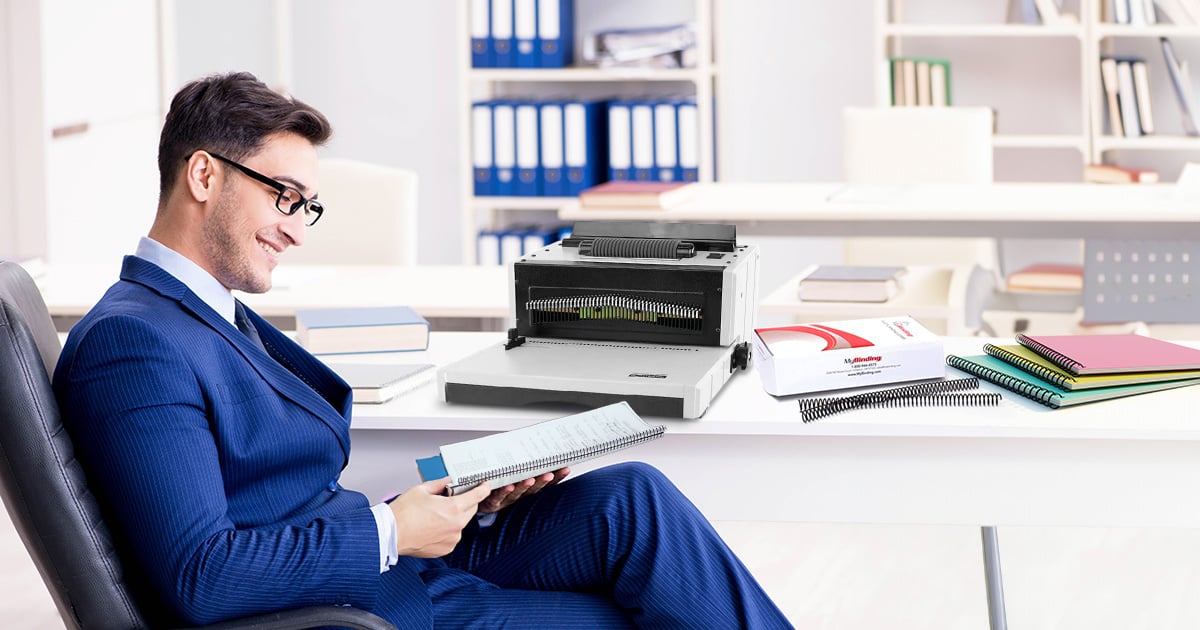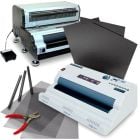Coil Binding 101 - Everything You Need to Know

Estimated Reading Time
4 Minutes
TLDR
Let’s take a close look at coil binding! This coil buyer’s guide explores everything from the basics to customizations and comparisons with other methods so you can get the full picture of this popular binding method. Learn how spiral can revolutionize how you bind your documents and why it might be the perfect solution for your needs.
Coil Binding 101 - Everything You Need to Know
Looking for a solution to transform your loose sheets of paper into an attractive, neatly-organized document? Whether you’re a small business owner, an office manager, or just someone who loves to keep things organized, coil binding is an excellent binding solution for numerous projects. This popular method doesn’t just keep your sheets together — it also lets you present them in a way that screams professionalism and attention to detail.
But what is it, and how can it help you? We’re giving you the answers. In this buyer’s guide, we’ll tell you everything you need to know.
What is Coil Binding
First, let’s look at what coil binding is, what materials it uses, and its applications. Often called spiral binding, coil binding uses a continuous spiraled coil to thread through holes punched along the edge of a stack of papers. And it’s a breeze to do:
- Use a spiral binding machine to pre-punch your holes.
- Thread the first inch of the coil by hand.
- Finish the coiling by hand or with a spiral binding machine.
- Cut and crimp them with a cut/crimp tool.
In just a few steps, you can take your projects from drab to fab!
Materials Used
Typically, coils are available in two materials: plastic and metal. Plastic coils come in various colors, creating a practical, customized look that’s perfect for creative projects or internal documents. They’re also incredibly flexible, literally bouncing back to their original shape when bent.
If you want a more sophisticated look, metal coil binding is your go-to. It’s great for those high-stakes business presentations and documents that need to stand the test of time. Because they’re made of metal, though, when they bend they will not be able to go back to the same shape.
Applications
Coil binding is a highly versatile solution for document organization and presentation. It has a ton of applications, like:
- Business proposals and reports
- Training manuals
- Calendars and planners
- Marketing materials
- Educational materials
- Creative portfolios
How Coil Binding Differs from Wire and Comb
While coil binding is the most popular binding option, a few other well-known methods may be better for different projects. Each method has its unique characteristics, advantages, and disadvantages. Let’s look at two other popular options: wire binding and comb binding.
Coil Binding vs. Wire Binding
Wire binding is another top binding method that uses a spiraled wire coil or twin wire loops to bind the pages. Let’s look at how it differs from coil binding:
- Durability: Wire binding is durable but can get bent out of shape, while coil binding is more resilient to wear and tear and can remember its shape.
- Flexibility: Both allow documents to lay flat and fold back 360 degrees, but spiral coils are more flexible.
- Appearance: Wire binding offers a more professional, traditional look, while coil binding is more casual and modern. Both are available in a variety of colors.
- Ease of use: Coil binding is a little harder to use because you have to thread the wires and cut and crimp them, while wire binding simply requires you to close them.
- Applications: Wire binding is better for formal documents like business reports, professional portfolios, and financial statements. Conversely, coil binding is more versatile and suitable for everyday uses like planners, school documents, and dynamic business presentations.
Coil Binding vs. Comb Binding
Comb binding is another popular choice that has been around for a long time. It has several notable differences from coil binding:
- Durability: Comb binding is less durable than coil binding because the plastic combs can break or pages can tear at the holes over time or in extreme weather conditions.
- Flexibility: Coil binding offers more flexibility because documents can open flat and fold back 360 degrees, unlike comb binding.
- Appearance: Comb binding provides a basic, functional look, while coil binding looks more polished and professional.
- Affordability: Comb binding is more affordable on a per-piece basis, making it an ideal choice for budget-conscious presentations.
- Ease of use: Unlike spiral coils, you can easily open and close plastic combs to add and remove pages as needed. They’re also a little easier to install since you just insert them and clamp them closed.
- Applications: Comb binding is ideal for frequently updated documents like manuals or reports thanks to its reusability, while coil binding is better for documents that need more durability due to frequent handling.
Common Users & Uses for Coil Binding
Various industries use coil binding to elevate their documents. Its unique blend of durability, ease of use, and semi-professional appearance make it a favorite for:
- Educational institutions: Student handbooks, course textbooks, research theses
- Corporate offices: Business reports, presentations, and training manuals
- Legal firms: Legal documentation, case files, contracts
- Restaurants and cafes: Menus and recipe books
- Healthcare facilities: Medical records, patient information booklets, and procedural manuals
- Creative industries: Portfolios, project presentations, scrapbooking, and design compilations
- Event planning: Planning guides, brochures, and promotional materials
Coil Binding Capacity and Color Charts
One of the best features of coil binding is its versatility. It’s available in tons of sizes and colors to handle various thicknesses and project needs. Let’s see how to choose the right coil size and color for your project.
Coil Binding Capacity
Coil binding sizes range from 6mm up to 50mm, allowing them to bind documents as small as a few pages and documents up to 450 pages thick. It’s always better to go a size up if your document is in-between sizes.
Here’s a coil binding size chart with corresponding sheet capacities so you can choose the right one for your project at a glance. “Sheet” refers to standard 20 lb. bond copy paper, so will vary if you are using thicker paper and to accommodate your covers.
|
Spiral Coil Size |
Sheet Capacity |
|
6mm |
30 sheets |
|
7mm |
42 sheets |
|
8mm |
54 sheets |
|
9mm |
65 sheets |
|
10mm |
75 sheets |
|
11mm |
85 sheets |
|
12mm |
92 sheets |
|
13mm |
105 sheets |
|
14mm |
115 sheets |
|
15mm |
125 sheets |
|
16mm |
135 sheets |
|
17mm |
142 sheets |
|
18mm |
155 sheets |
|
19mm |
160 sheets |
|
20mm |
172 sheets |
|
22mm |
190 sheets |
|
23mm |
200 sheets |
|
25mm |
220 sheets |
|
28mm |
250 sheets |
|
30mm |
270 sheets |
|
32mm |
280 sheets |
|
33mm |
290 sheets |
|
35mm |
310 sheets |
|
38mm |
330 sheets |
|
40mm |
350 sheets |
|
42mm |
360 sheets |
|
45mm |
390 sheets |
|
50mm |
440 sheets |
Spiral Coil Colors
In addition to being available in almost 30 sizes, spiral coils come in more than 60 colors to match virtually any color scheme or company logo. Talk about versatility! In fact, there are so many color options that coil binding even gets called “color coil binding”.
Here’s a snapshot of all the available colors you can choose from.

Custom Cut-to-Length Coil Bindings
Looking for binding that adapts to you instead of the other way around? Custom cut-to-length coil bindings are perfect for those unique or non-standard document sizes that need a personalized touch.
Spiral coils already give you over 60 color choices, and you can customize them even further with personalized:
- Lengths
- Pitches (the amount of punched holes)
- Diameters
- Colors to match your brand
Whether it’s an unusually sized portfolio, a special promotional booklet, or a non-standard company report, these custom coils can reflect your brand and bind your documents perfectly without those awkward overhangs or shortfalls.
MyBinding offers a wide range of high-quality custom spiral coils, complete with quick and easy ordering. Check out our custom options or call 1-800-944-4573 to see what’s best for you.
Benefits of Coil Binding
Coil binding is popular for good reason. As we’ve covered, it offers numerous benefits, such as:
- Versatility
- Durability
- Easy to use
- Professional appearance
- Ability to lay flat or fold over completely
Disadvantages of Coil Binding
While coil binding offers numerous advantages, it also has disadvantages such as:
- The initial equipment cost: Investing in coil binding machinery can be a significant upfront expense, especially for smaller businesses or people who don’t bind frequently.
- Complexity in larger volumes: While the coil binding process is pretty simple for smaller batches, it can become more complex and time-consuming at larger volumes when using tabletop machinery. You have to manually thread in each coil at the beginning and hold it against the machine for it to coil, which can be inefficient. Production-level volumes use automated machinery to solve for this problem.
- Limitations in binding thickness: While coil binding can handle documents up to 450 pages thick, large-size coils are kind of difficult to work with due to their extreme flexibility. It’s like trying to thread a slinky through your pages. They’re much easier to use with books less than one inch thick, which can be a big limitation if you need to bind thick documents.
FAQs
Is coil or wire binding better?
Both allow documents to rotate 360 degrees and open completely flat, but coil binding is best for projects where durability and flexibility in color choices are most important. On the other hand, wire binding is a better option for projects requiring a sleek, professional appearance.
Is spiral binding the same as coil binding?
Yes, spiral binding is another name for coil binding.
Is spiral bound better than hardcover?
If you’re looking for a practical, economical binding solution that allows pages to open 360 degrees and lay flat, spiral binding is the best choice. However, a hardcover (aka case binding or thermal binding) might be best if you’re looking for a more professional and durable solution.
Conclusion
Include a strong call to action and briefly summarize the article.
So there you have it — now you know everything you need to know about coil binding! This popular binding method offers many benefits that cater to various document-binding needs. It also comes with some challenges to keep in mind to decide if it meets your unique needs and preferences. Whether you’re a pro or new to the binding game, coil binding has something for everyone.
Got more questions? Check out MyBinding’s knowledge base for more information on coil binding. If you feel that coil binding is right for you, we offer high-quality coil binding supplies and equipment — including custom coils — to make your journey a success. Explore our extensive selection to find the perfect solutions for you or call us at 1-800-944-4573 if you need help along the way.







